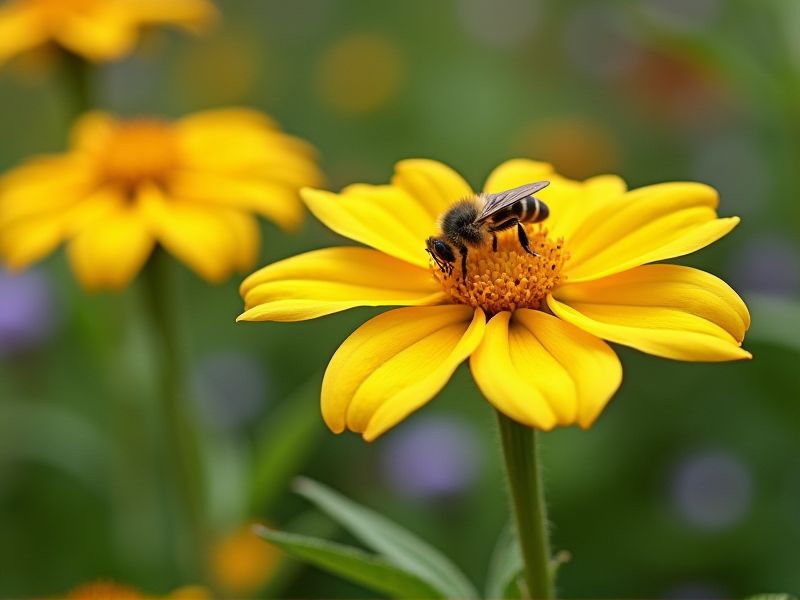
Consider incorporating species such as lavender, catmint, or coneflower into your garden landscape. These pollinator-friendly plants thrive in dry conditions, making them ideal for low-water environments. Xeriscaping with these varieties not only supports bees, butterflies, and other pollinators, but it also enhances your garden's resilience to drought. With their vibrant blooms and fragrant foliage, plants like salvia and yarrow attract a variety of beneficial insects while requiring minimal maintenance. By selecting these drought-tolerant options, you create a sustainable ecosystem that conserves water and promotes biodiversity.
List of some Pollinator-friendly plants that need little water
- Lavender (Lavandula)
- Agave (Agave spp.)
- Coneflower (Echinacea)
- California Poppy (Eschscholzia californica)
- Blanket Flower (Gaillardia)
- Yarrow (Achillea millefolium)
- Sea Holly (Eryngium)
- Stonecrop (Sedum)
- Manzanita (Arctostaphylos)
- Russian Sage (Perovskia atriplicifolia)
Important things about Pollinator-friendly plants that need little water
Native Species Attract Local Pollinators
Native species such as California lilac (Ceanothus), desert marigold (Baileya multiradiata), and butterfly weed (Asclepias tuberosa) play a crucial role in attracting local pollinators while requiring minimal water. These drought-tolerant plants not only conserve water resources but also provide essential habitat and food sources for bees, butterflies, and hummingbirds. Incorporating such plants into your landscape enhances biodiversity and supports the ecosystem's health. By choosing pollinator-friendly native species, you create a vibrant environment conducive to sustaining local wildlife.
Drought-Tolerant Varieties Conserve Water
Drought-tolerant plant varieties such as lavender, salvia, and sedum provide excellent options for pollinator-friendly gardens while maximizing water conservation. These resilient species not only thrive in arid conditions but also attract bees, butterflies, and other vital pollinators, enhancing biodiversity in your outdoor space. Incorporating plants like echinacea and yarrow will bolster your garden's ecosystem, supporting the habitat of essential insects. Emphasizing these drought-resistant, pollinator-friendly plants promotes sustainability and a thriving environment, all while minimizing water usage.
Deep-Root Systems Improve Soil Health
Deep-rooted systems, such as those found in pollinator-friendly plants, significantly enhance soil health by promoting moisture retention and nutrient cycling. Species like milkweed, lavender, and native wildflowers not only support crucial pollinator populations but also require minimal water, making them ideal for sustainable gardening. Your choice to incorporate these plants can lead to healthier ecosystems, as their extensive root systems help prevent soil erosion and enhance biodiversity. Moreover, their resilience to drought conditions ensures that your garden remains vibrant while contributing to a thriving environment for bees, butterflies, and other essential pollinators.
Flowers Provide Nectar And Pollen
Pollinator-friendly plants, such as lavender, salvia, and sedum, are excellent choices for creating a vibrant garden while conserving water. These drought-tolerant species not only attract essential pollinators like bees and butterflies but also thrive in arid conditions. By selecting native varieties, you can enhance biodiversity and support local ecosystems without extensive irrigation. Incorporating these plants into your landscape ensures that you provide nourishment for vital pollinators while maintaining a sustainable approach to gardening.
Seasonal Blooms Support Prolonged Pollinator Activity
Pollinator-friendly plants such as purple coneflower, yarrow, and sedum thrive in dry conditions, attracting essential pollinators like bees and butterflies throughout the growing season. These resilient species not only require minimal water but also contribute to a diverse garden ecosystem, offering shelter and food for various wildlife. By incorporating these drought-tolerant plants into your landscape, you can ensure a steady supply of nectar and pollen, promoting prolonged pollinator activity. Creating a habitat with locally adapted flora will enhance biodiversity and support the health of local pollinator populations.
Minimal Maintenance Required For Hardy Plants
Pollinator-friendly plants such as sedum, purple coneflower, and black-eyed Susan thrive with minimal water and attract a variety of beneficial insects. These hardy species are drought-tolerant and can flourish in poor soil conditions, making them perfect for low-maintenance gardens. You can create a vibrant habitat that supports butterflies, bees, and other pollinators while conserving water. Incorporating these resilient plants not only enhances biodiversity but also provides an effortless way to maintain an environmentally friendly garden.
Group Planting Enhances Visibility For Pollinators
Group planting creates a vibrant ecosystem that attracts essential pollinators such as bees, butterflies, and hummingbirds. By selecting drought-tolerant plants like lavender, sage, and coneflowers, you can create an environmentally friendly garden that requires minimal watering. These plants not only thrive in arid conditions but also provide rich nectar sources, supporting pollinator health and biodiversity. Incorporating these species into your landscape promotes harmony with nature while fulfilling the critical role of sustaining local pollinator populations.
Avoid Pesticides To Protect Pollinator Health
Choosing pollinator-friendly plants that require minimal water is essential for promoting pollinator health in your garden. Native species, such as lavender, salvia, and bee balm, thrive in dry conditions while attracting butterflies, bees, and other beneficial insects. Incorporating these drought-tolerant plants not only supports local ecosystems but also reduces the need for harmful pesticides, which can adversely affect pollinator populations. By creating a sustainable garden with a variety of these plants, you can foster a thriving habitat for pollinators while conserving water resources.
Sun-Loving Plants Thrive In Dry Conditions
Pollinator-friendly plants such as lavender, sedum, and bee balm are excellent choices for a sun-loving garden while requiring minimal water. These drought-tolerant species not only attract vital pollinators like bees and butterflies but also flourish in arid conditions, making them perfect for low-maintenance landscaping. By incorporating these plants into your outdoor space, you contribute to the health of local ecosystems while enjoying vibrant blooms. Consider creating a pollinator garden with these resilient varieties to support biodiversity and beautify your environment.
Resource-Efficient Gardening Promotes Biodiversity
Pollinator-friendly plants, such as lavender, sedum, and California poppy, are essential for creating a resource-efficient garden that supports biodiversity. These resilient species thrive in low-water conditions, making them ideal for sustainable gardening practices. Their vibrant blooms attract essential pollinators like bees, butterflies, and hummingbirds, enhancing the ecosystem's health. Incorporating native plants into your garden not only conserves water but also fosters a thriving habitat that contributes to the overall balance of nature.
